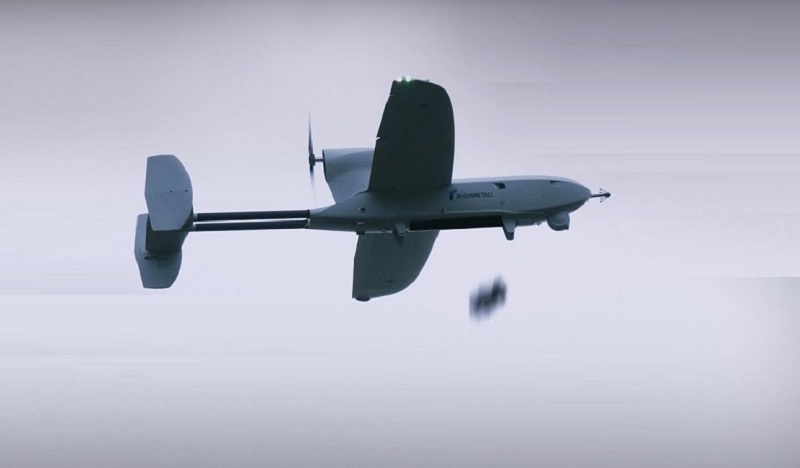German defense contractor Rheinmetall unveiled plans last month for a drone envisioned to carry up to eight loitering munitions and release them close to their targets. The drone then releases explosive loitering munitions which first destroy a perimeter sensor and then blow up the truck parked inside the structure. The drone carrier, dubbed Combat Drone, is based on the existing Luna Next-Generation (NG) platform, also manufactured by Rheinmetall and in service with different customers including the German Army. The Luna NG, whose predecessor is the Luna X-2000 that has been operated by German troops since the early 2000s, was formerly manufactured by EMT Penzberg before Rheinmetall bought the operation in 2021. It is a lightweight reconnaissance drone capable of remaining airborne for 12 hours over ranges above 100 kilometers. Soldiers can launch it by way of a rope hoist catapult. While the drone carrier idea is not new by itself, the design was likely influenced by the use of unmanned aerial vehicles in Ukraine.

This unmanned mothership can be launched via catapults that can work in all fields. This can save costs to carry out enemy reconnaissance and attack missions reliably and with minimal risk to troops. One of the unique features of the LUNA NG is its ability to glide without using engine power. This unmanned aerial vehicle (UAV) has endurance of 12 hours and a data link range of 100 kilometers (62 miles). Satellite Communications will increase its range. The drone is made of fiberglass composite with a takeoff weight of 40 kilograms (88 pounds) and flies at a service altitude of 5,000 meters (16,404 feet).The vehicle without a runway can be launched by catapult and landed by parachute and has a stealth feature with low acoustic, thermal and radar signatures. The various shooting targets in the tactical battle targeted by this drone are various important enemy facilities such as railroads, supply lines, fuel depots, or ammunition depots.

Rheinmetall and UVision are developing Hero-R rotary-wing loitering munition. The multirotor Hero-R can be launched from a mission pod on a vehicle and has a 10-minute flight time. An example he gave of its employment was landing Hero-Rs in the corners of trenches to destroy them. The Hero-R is intended for close combat as an effector for combat vehicles and dismounted soldiers. There will be two sizes – weighing around 1.5 kg and 2.5 kg – both with a maximum speed of 70 km/h and with warhead options – blast, fragmentation, and armour piercing – ranging in weight from 500 g to 1 kg. He explained that Hero-R had an endurance greater than 10 minutes, not to wait for a target but to travel to the general area where a target is located in close-combat situations. Hero-R will be able to cover the area of responsibility of a platoon or company with an engagement range comparable to that of a vehicle main gun and anti-tank guided missiles to attack targets in or behind cover.















